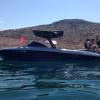
bhanson
Crew-
Content count
125 -
Joined
-
Last visited
-
Zapisor, I have a 2007 Typhoon. Not sure what was included in the "upgrade package" from the Concourse, but glad to take a shot at any specific questions you might have.
-

Transfer system for fast side-to-side switch
bhanson replied to bhanson's topic in Centurion Boats General Discussion
Ha, guess I raised my hand so might as well continue the conversation ... ;-) Fortunately whats on paper and reality are very close here. Head pressure consists of several components: a) height of the liquid (independent of hose diameter), friction loss thru the pipe, which is a function of diameter, length, flow rate, and material, c) friction loss thru fittings, bends, abrupt contractions, etc., d) other minor stuff (depending on precision required, not much here). In our ballast systems, the friction losses in and c) are pretty much a "given" based on the layout of our pumps, sacs, and required hose routing, but routing into the bottom reduces the "height of liquid" part of the equation and can have a noticeable effect on the real performance of an aerator pump. Again, not trying to lecture and not claiming some breakthru "ballast panacea", just pointing out that not all "common knowledge" is accurate and that we need to push the industry to be smart and to innovate. Sheez, Fly High literally told me their port sizes are just fine (as Wylie points out, pretty lame once you measure them !!!), that I should just order a custom bag with lots of ports and join them via manifold, and that I should switch from Tsunami fill pumps to Ballast Puppies because they are way faster. That is simply stale thinking and inaccurate, and IMO illustrates a lack of knowledge which leads to a lack of innovation, and innovation is what we are all HUNGRY for. Apologize for the late night soap box. Appreciate the Crew's insights, and feel obligated to share as I take, so hopefully the conversation is positive and beneficial. "Pushing against Water": I understand whats on paper, but im not an engineer, i deal with reality in the real world. Head pressure is a result of height and distance x hose diameter. Basically the amount of water in the line. If the pump is filling into the bottom fitting of the sac, then the amount of water in the sac is tacked on to the equation. It absolutely adds to the head pressure on the pump, reducing its effective flow rate. Yes, 24" lift into the top of the sac means a constant head pressure. Filling into the bottom means a progressively increasing head pressure. Using hydraulic system principals like brakes and forklifts is different. They use pressure systems that are positive displacement and are not effected by lift like an aerator pump. Not -

Boat would not plane with full crew
bhanson replied to N8 Froelich's topic in Centurion Boat Maintenance, Performance, Troubleshooting
Different boat, motor, and prop, but anecdote nonetheless. When I was piddling with a homemade surfgate I did a test with both 1100# sacs full and nothing up front. Boat would not even come close to planing, and I have an aggressive low-pitch surf prop. So, yes, with that many people it seems reasonable to move some up front to get moving. WRT wakeboarding, you typically run about 40% of your weight up front, which inherently helps get on plane. -
Take 2: America, HELLLL YEAHHHH !!!
-
;-) and so hopefully you have a good visualization of the "positive response" I mention.
-

FAE Fresh Air Exhaust
bhanson replied to Bob U's topic in Centurion Boat Accessories, Electronics and Modifications
Yes, it works great, not sure if you have another question in there though. The FAE dramatically reduces exhaust noise (if that is what you want) and the CO safety aspect is very important to me (station wagon effect in the boat, not on rider). However, you are dragging a tube thru the water so can/will cause some spray, which may or may not bother you. I love the FAE, and love educating the local water police when they stop me to explain the perils of surfing (yes, on multiple occasions, sheez ...). -

Transfer system for fast side-to-side switch
bhanson replied to bhanson's topic in Centurion Boats General Discussion
1) Agreed, does anyone know if Fly High changed their message since the previous responder mentioned 1.5" ports in some bags? I have not seen that to date, thus the DIY approach. 2) Agreed, properly configured aerators work as-advertised. I have no dog in the aerator-vs-impeller fight, just looking for the best solution and aerators work very well for me. Our boats' deep Vs make it very easy to "properly configure" aerators below water line for reliable priming and adequate water supply. 3) Yes, that is conventional wisdom and where I started the process, but some other things went into my approach: - Filling into the top of each sac is non-trivial with 1.5" hose, that stuff is stiff and tough to route, would likely have needed to use PVC fittings to make the bends. - The head loss thru the pump housing was very low, as confirmed by my initial testing and consistent with what I see on the water; i.e., near "theoretical" transfer times, very little head loss thru the pump, very surprising !!! - Routing into the top of the bags requires longer length of hose with multiple bends, all of which increase head loss and reduce pump performance. I have almost a direct shot between sacs. Plus, it is a very clean install. - The valve was a bit pricey, but 1.5" hose, fittings, and check valves are certainly not inexpensive. Paid some minor premium for sure, but easily justified by the benefits. Note: I have heard the expression "pushing against the weight of the water" for a long time and must make a comment/observation. Pump performance is a function of "head", which is expressed in feet or inches and relates directly to PRESSURE and not WEIGHT. I.e., one foot of water "head" creates 0.43 psi of back-pressure against the pump, regardless of if that pressure is in a small hose or a huge bag full of water. If you route your hose up 24" then into the top of a sac, you have a constant head of 24" against the pump. If you route your hose straight into the bottom of a sac, then you start the process with zero head and the head increases as the bag fills; overall much higher performance if using an aerator pump. In reality, the pump is never "pushing against the weight of the water" but rather pushing against the head (which is a pressure, expressed in feet or inches). Not trying to be a smarta$$ here, this is simply how/why hydraulic systems work (brakes, forklifts, etc), and how our ballast systems work. Now, if it would stop raining here in Denver I could stop piddling on the boat and actually get out on the water and RIDE !!! WooHooo !!! -
Oops, appears I have exceeded my allotted space for attachments so no picture. Happy 4th anyway.
-
America, HELL Yeah !!! Happy 4th, belated, from Lake McConaughy.
-

Transfer system for fast side-to-side switch
bhanson replied to bhanson's topic in Centurion Boats General Discussion
Ha, you are exactly right, and that sparked a side-conversation. Very relevant observation, glad to see some things getting incorporated into the new models but the aftermarket for retrofits has got to be significant for those pump manufacturers; I for one am not a candidate for a new $120K boat but would drop some coin on upgrades (like I just did). On a another side note, when I started this whole process I called Fly High, who shared two pieces of wisdom: 1) "The current 1.125" ports are more than sufficient, why would you need a 1.5" port?" --> did that change very recently? 2) "Impeller pumps are much faster than any aerator pump, period" --> talk about a blanket statement that is a bit, dare I say, erroneous? I tried being rational, explain what I was doing, trying to get constructive input on the port install and trying to understand if they had knowledge a big, bad new pump, but overall was just a frustrating conversation. -

Transfer system for fast side-to-side switch
bhanson replied to bhanson's topic in Centurion Boats General Discussion
Yep, look at the current draw of an impeller -vs- aerator, compared to the flow. The Rule moves 4X the water at roughly the same power draw, so have to wonder if a high-volume impeller pump will be electric or if it will be driven off the engine like the raw water pump. Sure there are smart, well-paid engineers looking at all the next-gen stuff, but doesn't do much for me and my 2007 Typhoon this summer. ;-) -

Transfer system for fast side-to-side switch
bhanson replied to bhanson's topic in Centurion Boats General Discussion
What matters most ... ;-) Our setup includes 1100s in the rear lockers and 500# of lead on corner of sundeck. If it is just the two of us, we add a sac in center of rear seat (shown in pic). To switch from goofy to regular the driver hits the transfer switch, the new rider drags lead to other side (60 seconds, max) and jumps in the water. The picture shows me at the end of a 15' rope tied to the ski hook, so I am a roughly 18' back with a solid, pushy wave. Regular wave is a bit taller, same length. We now have harmony amongst our "blended family". Mission accomplished !!! -

Transfer system for fast side-to-side switch
bhanson replied to bhanson's topic in Centurion Boats General Discussion
More install pics -

Transfer system for fast side-to-side switch
bhanson replied to bhanson's topic in Centurion Boats General Discussion
Install pics -

Transfer system for fast side-to-side switch
bhanson replied to bhanson's topic in Centurion Boats General Discussion
6) Siphoning fixes Figured I could fix the siphon issue in one of two ways: - vacuum-breaker: cheap, passive, but would still have huge hoses running around my lockers - valve: pricey, active (more to break), but would make system much cleaner Selected the valve approach to eliminate the huge hoses running around my lockers, and added a certain "cool/style" factor. ;-) 7) Final setup - Rule 17A pumps connected back-to-back with 1.5" SpaFlex hose - 1.5" ball valve with 12V actuator from Baco Engineering - Ebay purchase from China, roughly $175) - Actuator purchased in "CR2-02" wiring configuration, so opens when power is applied and closes when power is shutoff - Rule 17A pumps connect to sacs and hose with flex-connectors, making them very easy/fast to remove when needed (like at the DeCon station) - Hard to tell, but the 17A pumps are rotated slightly within their bases to align better with the natural bend in the hose (can never get that stuff straight after being coiled on a roll) - Carling DPDT switch - had an open slot on my switch panel - pumps and valve both grounded on grounding block under the dash - pump "hot" wires connected to opposite "throws" of the switch; press switch to the right to transfer to goofy side, press switch to the left to transfer to regular side - valve "hot" connected to both "throws" of the second switch "pole"; press switch either direction and the valve opens - Valve is zip-tied to a bracket for support. Valve is offset from center of hose to avoid hitting the vent, and did not want water coming thru the vent onto the valve actuator





